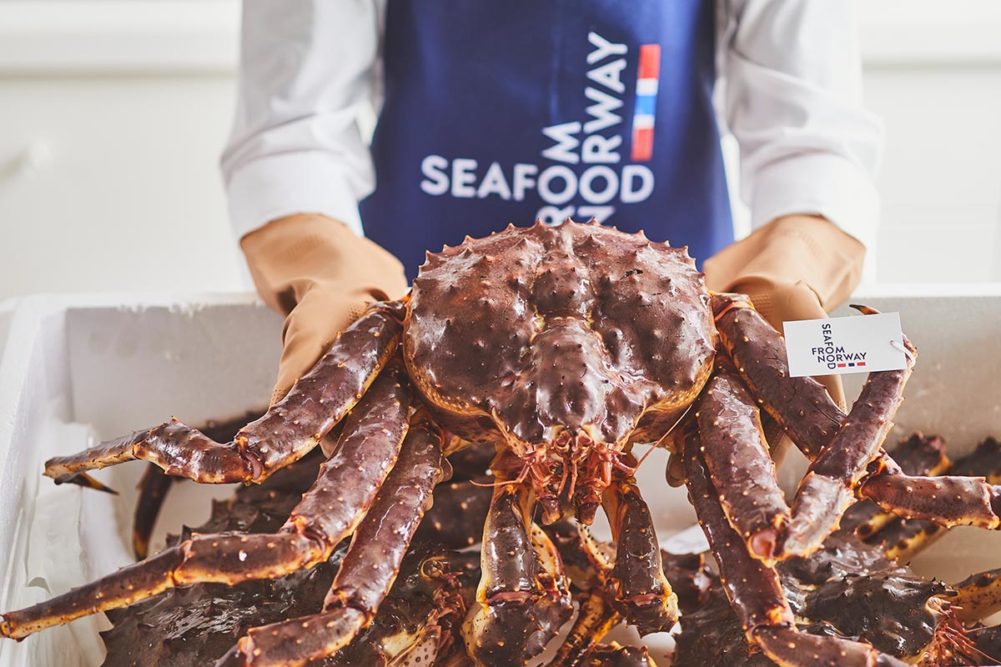Norwegian producers are currently shipping queen snow crab (live and frozen), red king crab (live and frozen), Norway lobster/langoustines (live), common whelk, frozen coldwater prawns (shell-on and peeled), brown crab and frozen scallops for sale in US grocery stores.
Norwegian red king crab in particular has become very popular in the US, said Anne-Kristine Øen, director, USA, for the Norwegian Seafood Council. High-end Asian cuisine is one popular destination for the variety.
And, based on developments in two other areas of the world where red king crab is sourced, that popularity will only increase, Øen said. One, the US has banned red king crab exports from Russia because of the Russia/Ukraine War. And two, Alaska red king crab stocks have collapsed.
Russian scientists brought red king crab to Norwegian and Russian territorial waters in the 1960’s. Since then, it has established a habitat along the coast in the eastern part of Finnmark, a county in northern Norway, and has become an invaluable resource of Norway’s northernmost fishing region.
Red king crab is a highly adaptable crab that feeds on bottom-dwelling animals and algae alike, and it has been known to spread along the Norwegian coastline, leaving terror in its wake, Øen said.
For that reason, Norwegian authorities have established a two-part strategy for maintaining a sustainable red king crab population: a quota-regulated, long-term fishery in east of Finnmark; and limiting the crab’s dispersal outside of this designated area.
“In order to protect other valuable species like the cod, all king crab fishing in areas west of the North Cape is therefore unrestricted. Fishing for the red king crab takes place all year with traps in the fjords and coastal areas along the east of Finnmark.”
But red king crab is far from the only variety of shellfish from Norway that has enjoyed strong growth in recent years, Øen said. Frozen snow crab volumes are up due to higher quotas and landings in Norway, and US demand has been there to meet it.
Looking at overall shipments, export volumes of shellfish from Norway have been on a steady rise, especially for snow crab, king crab and Norway lobster. Demand for other species has fluctuated more, Øen said.
In marketing their country’s shellfish, the Norwegian Seafood Council highlights the country’s cold, clear water, which gives shellfish a “special and sweet taste and a unique texture,” Øen said.
Because of its status in the shellfish category, Norway must work hard to differentiate itself from other producers.
“Norway is a niche producer of shellfish compared to other countries such as Canada, Russia, the UK, France, and the US,” Øen said. “We must make the most out of the little exclusive resource we have and deliver the best quality.”
One shellfish variety that is making a comeback in Norway is the arctic scallop.
In the 1980s, arctic scallop fisheries were closed due to overfishing. Now that producers have once again been given the green light to fish for the variety, two vessels have been given a five-year research quota of 5,000 tons of artic scallop each year due to development of new harvest technology.
The seabed harvester installed on board of one of the vessels, for instance, is completely new and cannot be compared to other fishing gear, Øen said — it hovers above the seabed and is able to precision-pick scallops (and other seafoods) gently yet efficiently without touching the seabed.
Equal opportunity
Anne-Kristine Øen, director, USA, for the Norwegian Seafood Council, said her country’s shellfish industry has made leaps and bounds in gender equality in recent years.
“It is quite unique that the female share is increasing, especially in the crab fishery. Some own their own small coastal vessels fishing for king crab. Others are vice captains, factory managers or crew members on board the snow crab vessels harvesting in very tough conditions far out in the arctic Barents Sea.”

